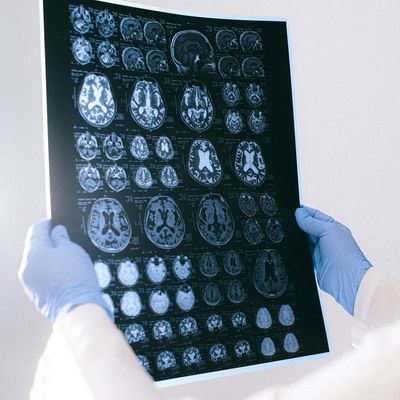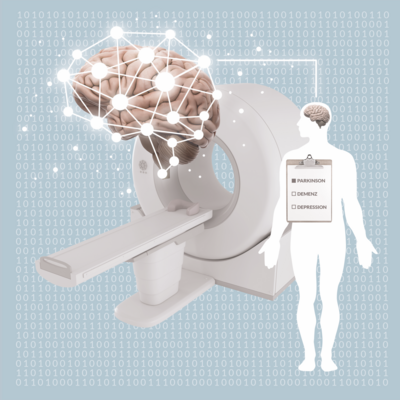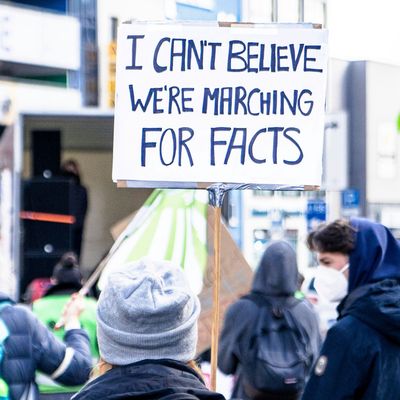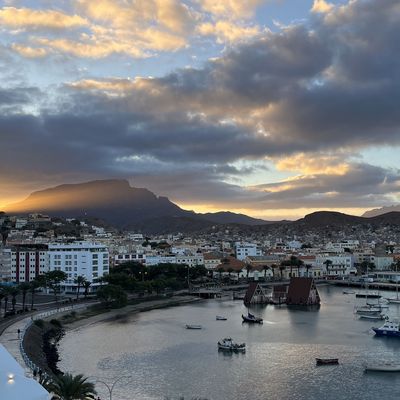The Neutron Collector

When stars explode, particles are hurled into space, which then rain down on Earth as neutrons. Scientists use this process to measure soil moisture. One of these scientists is Leipzig physicist Martin Schrön. He wants to use this to help farmers and environmentalists improve their response to climate change.
Last summer, Martin Schrön regularly got his off-road vehicle ready and drove around the open fields. The mobile measuring station inside his “Cosmic Ray Rover” scans the environment while driving. How many neutrons are in the air? The neutron detector is in the trunk of the rover. It is comprised of a tube filled with helium-3 gas. The tube is connected to a data logger that records the findings. A small red light briefly flashes each time a neutron flies into the tube. The detector finds thousands of neutrons when Martin Schrön rumbles over dirt roads, streets, and meadows in the rover. “And then we have a pretty accurate idea of the soil moisture.”
But wait a minute, what do neutrons have to do with soil moisture? And why are we even talking about cosmic rays standing here on tilled soil surrounded by wheat, rapeseed, and fallow land? Schrön laughs. “Because they have a lot to do with each other.”
Few people can explain it as beautifully as the Leipzig physicist, who has been using findings from astronomy for hydrology at the Helmholtz Centre for Environmental Research (UFZ) in Leipzig for seven years. “Neutrons are our heroes in environmental research,” says Schrön. How so? “Because they can tell us a lot about water.” Here’s how it works: “When stars explode, they hurl their components out into the universe, mainly protons and electrons.” These are cosmic rays. “The protons turn into neutrons when they hit the Earth’s atmosphere.” Then the neutrons rain down on Earth. Because neutrons are electrically neutral, they are not deflected by the charged atomic shells and pass through almost all atoms unobstructed. In the case of farmland, this means that the neutrons patter onto the ground and slip easily through soil, roots, and stones. If they hit the atomic nuclei, however, they bounce off and jump back into the air. They are reflected, as they say in physics
“Neutrons are our heroes in environmental research. Because they can tell us a lot about water.”
Martin Schrön, scientist at Helmholtz Centre for Environmental Research
It´s like playing pool
Unless they hit hydrogen, the lightest atom of all. Hydrogen is the same weight as a neutron and can therefore slow it down, causing the neutron to remain stuck in the ground. Schrön explains, “It’s like playing pool. A ball bangs against a stationary ball of the same weight, which absorbs its energy. The ball you hit stays where it is and the other one rolls away.” So when farmland is full of water, there are hardly any neutrons floating above it. When it is dry, many reflected neutrons buzz around in the air. This is exactly what the detectors Martin Schrön and his team drive around the fields record. “We can use this to predict flooding, for example.” If a vast rainfront is approaching, you have to take ad hoc samples and check soil moisture. “If the ground is already very wet, the rain cannot drain off; flooding is more likely to occur and the region can take precautions.”
Considering climate change, such a precise early warning system is worth its weight in gold. Weather extremes are increasing, from floods to heat waves. However, conventional satellite measurements are far too inaccurate. They only measure soil moisture to a depth of about an inch or so. But this top inch is often deceptive as it dries out very quickly there. The soil below, however, often still contains enough water, so artificial irrigation would be pointless. Or, if the soil is very damp, it can no longer absorb much water during flooding. You can measure further down using traditional hand-held measuring instruments, but they only register a small area. So measuring entire fields using these is not very realistic, but with neutron measurement it’s easy. This is because this method mixes air from 25 to 50 acres and can therefore provide reliable measurements for large areas. The stellar explosions in space can help farmers prepare for and counteract drought in time. How long will the heat wave last? Do we need more irrigation? How much more water can my soil absorb?
Getting to the bottom of things has fascinated Martin Schrön since he was a child. Whether it was about the universe or the potatoes in his father's garden that wouldn't grow.
A sunny spring day in Leipzig, Helmholtz Centre for Environmental Research. Today, astrophysicist Schrön sits at his desk, evaluating data, planning the next measurements, and thinking about how to improve the neutron method. “The data are sometimes difficult to interpret, especially in varied terrain,” says Schrön. This is because the environment influences the measured values. If the detector is driven along an asphalt road, this will usually be drier than the adjacent farmland. The soil is usually less moist on a compacted dirt road than in open farmland. And why the heck does the detector sometimes catch fewer neutrons than expected when traveling over dry soil? Maybe the lake around the next bend is swallowing up all the neutrons. “Everything in the area sends out signals: houses, trees, cars,” says Schrön. “We are working on computer models to make it easier to interpret the data.”
How are stars formed in the galaxy and why do atoms combine to form molecules?
Why do neutrons race through the air, how are stars formed in the galaxy, why do atoms combine to form molecules – questions like these have fascinated Martin Schrön since he was a child. It didn’t matter whether it was about the universe or about the potatoes that wouldn’t grow in his father’s garden. What was wrong with the ground? Schrön calls it “the joy of getting to the bottom of things”. That has been his motivation this whole time. That’s also why he studied physics. He chose to go to the University of Heidelberg, where institutes of different disciplines come together: astrophysics, particle physics, biophysics, environmental physics, and so on. Just the right thing for someone who wants to see the big picture.
Schrön earned his degree on the origin of the stars. Because he had his first child shortly thereafter, the young scientist moved his family to Greifswald and switched from exploring the stars to exploring the moors. He later transferred to the Helmholtz Centre for Environmental Research in Leipzig. The first neutron measuring instrument has just come onto the market and the method now needs to be tested and improved. Just the right thing for Schrön, who likes to combine his love of nature and astrophysics. “Hydrology and earth science were new research fields for me and I had to familiarize myself with them first.”
Since then, Schrön has been right in the thick of it all. Sometimes he trudges through large areas of farmland with the sensors. Sometimes he broods over formulas or develops simulations to assess the effects of environmental factors. How much does the intensity of the sun influence cosmic rays? How can the measurement findings be used for other regions of the world? As a physicist, the 34-year-old has a different perspective on the problems than the hydrologists from his department. Should we include particles at quantum level in the calculations? Can we measure soil moisture from a helicopter or train? “Only interdisciplinary collaboration can move us forward in this field of research.”
Using weather models to better predict the course of heat waves?
Two years ago, scientists from eight institutes joined forces to form the Cosmic Sense Research Group of the German Research Foundation (DFG). Particle physicists, geoscientists, remote sensing experts who work with satellite images, and hydrologists who simulate the paths of water through the landscape are also part of the team. Together, they build new types of detectors, develop better approaches for correcting and analyzing measurement data, program simulations of water flows in the soil, and try out new measurement methods.
There is still so much, says Schrön, that we don't understand. How exactly do heat waves occur and how can we predict how long they will last? Are our prediction models good enough? What influence do the condition and capacity of the soil have? In the coming years, Schrön and his team plan to collect on site data before, during, and after heat waves. “This will help us train our weather models and thus perhaps better predict the course of heat waves in other regions,” says Schrön. “But to do this, we must have a clear understanding of the processes behind them.”
One click on YouTube is enough to see that Schrön is serious about this. On science shows like FameLab, he happily jumps onstage in blue overalls and a check shirt. With a mischievous smile in the corner of his mouth, he shakes out a light, white silk scarf. “Let’s imagine this is a big galactic gas cloud floating around the universe,” he says, as the scarf floats through the air. “The gas cloud will of course get bored and will gradually collapse due to gravity,” says Schrön as he bunches the cloth up, “and become ever denser and ever warmer because of it,” crumpling up the cloth even more. “It eventually compresses enough to form a star.” And there you have it, Schrön conjures up a small yellow ball out of the wadded up scarf and grins. Simple, right? In 2015, the astrophysicist even won the German Science Slam Championship as well as the Klaus Tschira Prize for Science Communication in 2018.
Do image data help to better understand the influence of the environment on the neutron density above ground?
In the meantime, Schrön hardly has any time left for science shows. He dedicates all his energy to research. Recently, cameras mounted on his Cosmic Ray Rover have been taking pictures of the landscape during the measurements. The image data should help to better understand the influence of the environment on the neutron density above ground. For example, why was that one farm in northern Bavaria so dry on June 16, 2018? What did the landscape look like back then, what plants were growing in the fields? Does this help us to better interpret the measured data? Schrön explains, “But of course we can't analyze thousands of photos by hand.” We need the help of artificial intelligence.
But in order for the AI to help, it must first be thoroughly trained. “While differentiating between streets, trees, grasslands, swamps, rocks, cities, and vegetation is child’s play for humans, it is a Herculean task for computers.” Every tree, every plant, every street looks different, and computers have to learn to distinguish and sort them in photographs. But how? Martin Schrön and his department cannot solve this problem on their own. “I don't have the slightest idea about artificial intelligence,” says Schrön. “It will take covert machine learning experts to crack this nut.” Until he finds help with this, Schrön continues to cruise around in the Cosmic Range Rover collecting photos and catching neutrons from space.
Text by: Anja Dilk











